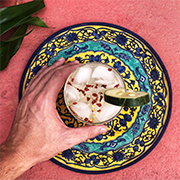Tequila Event
Tequilas from Los Altos highlands and Jalisco valley
Phone
(310) 856-5488
Website
Price
$$0
Overview
.
Carlos Andrés Ramírez
What's This Class About?
You’ll Learn the Differences between tequilas from Los Altos highlands and Jalisco valley
Anyone who has visited Arandas, in the Jalisco highlands, has had a chance to enjoy a sunset in its agave fields, UNESCO World Heritage since 2006. It’s sensational. Red soils fuse with the horizon as sharp tequilana weber spines align, like origami, across a sea of blue-green vegetation. From this terroir—with its perfect combination of soils, subsoils and climate; the right sunlight, wind and rain; slopes at ideal angles and at a perfect cultivation altitude—come the finest distillates, all with specific organoleptic traits.
About weather
Carlos kicks off thinking about weather in the highlands, an area more than 2000 meters above sea level. ¡It rains from mid-July until the end of September! Last year, Arandas got more than 800 millimeters. There’s also a big temperature drop at night, between ten to twenty degrees centigrade. Nights are cold in Arandas. And this thermic range means the agaves can accumulate more sugar. In the valley, it rains more (950 mm annually) than in Arandas. Since it’s close to the ocean, the air is more humid; temperatures average ten degrees hotter than in the highlands. The temperature stays higher, even at night.
About soils
Los Altos it’s a land of clayey, reddish soils, rich in iron. When it rains, the ground closes up and that means water runs off or puddles on the surface. The PH is slightly lower, so if you’re raising agave, you’ve got to use farming lime.
In valleys, the terrain is gray, reflecting an abundance of obsidian, a volcanic rock. That’s what allows the ground to retain more moisture, which can support more undergrowth. The area requires less intense cultivation so farmers may slough off.
It’s important to highlight that climate, soils—even agave-size—all influence the organoleptic profiles of tequilas produced in Jalisco’s Los Altos highlands as well as its valleys’ lower elevations.
About Agave
On a well-tended Los Altos parcel, agaves can weigh up to an average of forty kilograms and contain a total sugar-differential of 25-26%. In contrast, lowland agaves average just 20-40 kilograms; sugar-differentials hover between 21 and 23%.
About Organileptic Differences
Carlos pours two glasses, one with Altos highland tequila; the other contains a lowland blanco variety. He adds a little water to bring out aromas and flavors.
Then, he smells the first glass and say Altos-produced tequilas tend to be fruitier, and sweet, with herbal notes. Sometimes you can even smell wet earth. Flavor usually goes with aroma; it can be sweet and fruity. The body is robust.
They, he moves on to the second glass. Valley tequilas evince major herbal and mineral notes and the taste of alcohol is strong, too. The body skews less complex and the impact on the palate can be intense, maybe astringent.
This kind of tequila features fewer sweet or fruity notes and tends to be more acidic. There’s this dry sensation in the aftertaste, and sometimes, it even dulls the palate.
Also you can see differences between distillates that come from different terroirs, as in single-malt scotches, for example. Carlos recalls that In Speyside, you’ve got sweet, flowery whiskies; highland scotches are spicier. You can taste smoke, salt and iodine in an Islay. In the end, the reality is that all of who works in tequila face is the need to educate consumers about differences between distillates that come from the Los Altos highlands, in comparison to those produced in Jalisco’s valleys.
Tastings show people there are innumerable characteristics that can lead to new discoveries in every sip. After he start drinking solid, 100% agave tequilas, he defines preferences for sweet and fruity or herbal and mineral, etc.
Why take this SommClass?
Learn How Tequila made?
The process of making Tequila begins in the field with the blue agave plant, which takes at least seven years to reach maturity. It’s still harvested by hand, an extremely labor-intensive effort, before being cooked.
Better understanding of a Mexican Spirits
Increase your culture sensitivity.
What is special about tequila?
If you are sipping a Blanco or Silver, you will smell and taste sweet citrus and fruit notes, roasted agave, floral or herbal notes just to mention a few. With Reposados, since they are aged from 2-12 months in oak barrels, they take on flavors of wood, vanilla, caramel, etc
Why is tequila the healthiest alcohol?
Tequila has numerous health benefits (and is lower in calories than Smirnoff vodka). Agavins, the natural sugar found in tequila, are non-digestible (meaning they act like fiber) and won't raise your blood sugar levels. Furthermore, the sugar is shown to help lower cholesterol and can help you lose weight.
Is Tequila good for your immune system?
The fructans from which tequila is derived may give probiotics, which boosts our immune system
Your host

Carlos Andrés Ramírez
Carlos Andrés Ramírez is a Hospitality/Business Manager with emphasis in food and beverage and wine and spirits industry. He´s certified expert in Wine and spirits (advance level) by WSET (Wine and Spirits Education Trust), Sommelier by Escuela de los Sentidos in Chile; Trainer by International Bartending Association, Master of Whisky by Chivas Brother in Scotland and Tequila expert by Consejo Regulador del Tequila. Carlos also serves the role as Global Advocacy Manager for Pernod Ricard House of Tequila brands.
How to participate
This experience is hosted online.
Once you book, you’ll receive an email with a link and details on how to join.
What to bring
Indispensable
Desktop computer or mobile phone
Stable internet connection
Optional
Tequila from Los Altos
Glass of water
Availability
Things to keep in mind
Communication
Always communicate through our support email (class@sommtable.com)
ID Please
You’ll need need to confirm you're legally over the age of 21 before accessing the classroom
Guest requirements
You’ll need an internet connection and the ability to stream audio and video to participate. A link and details on how to join will be included in your booking confirmation email.
More tips
Please make sure that you have the Zoom app (www.zoom.us) downloaded on your smartphone, computer, or tablet.
Cancellation policy
Any experience can be canceled and fully refunded within 48 hours of purchase





 Share
Share
Sample Comment
24 Apr 2024
Wine and food lovers, and travelers alike have illustrated genuine consumer goodwill by taking to the web to share their best and worst eating experiences. If you´re eager to share your hits and misses, here are some points to write a compelling restaurant review that cannot be ignored.
1) Offer Some Background
2) Give Both Pros & Cons comments
3) Name Specific wines and entrees
4) Evaluate the Entire Experience
5) Let Your Personality Shine Through.